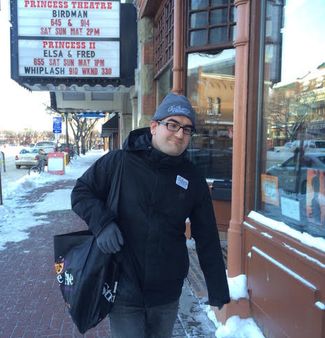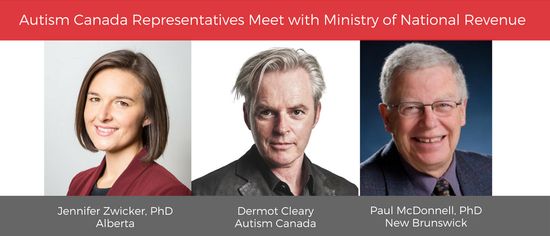#MakeDTCFair

On Thursday, February 1, 2018, Autism Canada testified at the Senate Standing Committee on Social Affairs, Science and Technology regarding the Disability Tax Credit (DTC) and the Registered Disability Savings Plan (RDSP). During this meeting, Autism Canada discussed our five recommendations for improving accessibility to the DTC and RDSP:
- Create clear, transparent and informed processes for applications, reviews and appeals;
- Develop clear, consistent and universally accepted classification criteria for disabilities;
- Uncouple the RDSP from the DTC;
- Monitor and evaluate population-based disability data at the federal level; and,
- Include the neurodevelopmental community on the Disability Advisory Committee.
Read the full Senate Committee Submission here.
DTC Statement from Ontario Physicians

There is an urgent need to making the application more explicit in what the CRA is looking for with regards to eligibility criteria and providing feedback to physicians about what the CRA is not currently approving based on the current categories. This lack of transparency in the decision-making process is contributing to inefficient use of physician resources and a lack of ability to advise families on eligibility for the DTC. We would be very willing to discuss our experience in more detail, and can be reached at m.s.zubairi@gmail.com.
Dr. Nicola Jones-Stokreef
Chair, Physicians of Ontario Neurodevelopmental Advocacy
Dr. Shawn Kao
Chair, Pediatric Section, OMA
Dr. Hirotaka Yamashiro
President, Pediatricians Alliance of Ontario
More About Applying for the Disability Tax Credit
In spite of the current problems with the Disability Tax Credit, it still has the potential to provide crucial tax relief for individuals with disabilities and their families. Revenue Canada has online information about the credit, who is eligible for it, and how to apply:
What is the disability tax credit?
 Being eligible for the DTC can open the door to other federal, provincial, or territorial programs such as the registered disability savings plan, the working income tax benefit, and the child disability benefit.
Being eligible for the DTC can open the door to other federal, provincial, or territorial programs such as the registered disability savings plan, the working income tax benefit, and the child disability benefit.Find out how you can benefit
Who is eligible for the DTC?
How a physician completes the DTC application form may also affect the individual’s eligibility. For that reason, the Canadian Paediatric Society has provided physicians with a resource to help them complete the DTC application when the client has an autism diagnosis.
There is also a volunteer-run Facebook group where members support each other in applying for the DTC and opening RDSPs.
Preparing for Employment with ASD
The unemployment statistics for those with autism is in the range of 70-80%. Reading such a statistic makes one ask, “Why is this so?” As a parent of two young adults with autism who finished school in June 2017, I am starting to see firsthand why finding a job is difficult.
 There are so many skills needed to be successful in a job. Some of them are:
There are so many skills needed to be successful in a job. Some of them are:- Presentation – good hygiene, neat appearance
- Communication
- Time management
- Organizational skills
- Adaptability
- Flexibility
- Decision-making
- Ability to work independently
 Volunteering provides an important opportunity to prepare for the world of work. People with ASD need time and experience to build skills and feel comfortable out in the community. Volunteering within a preferred interest can help a person meet other like-minded people who share their passion for that activity.
Volunteering provides an important opportunity to prepare for the world of work. People with ASD need time and experience to build skills and feel comfortable out in the community. Volunteering within a preferred interest can help a person meet other like-minded people who share their passion for that activity. Redefine Work
Redefine Work Due to a lack of traditional work experience in the teen years, putting together a resume for individuals with ASD can be challenging. Think about creating a non-traditional resume of skills and interests. Because both of my children have difficulty communicating, I plan to do this with visuals. I will use photos of things they have done to be able to show a potential employer that they do have skills and interests that could benefit a business. Photos or other visuals could also help in an interview or intake process because high anxiety can cause a communication shutdown. I took the last 6 books my son had read to his intake interviews because he just couldn’t answer questions or speak due to nerves. It showed the interviewer that he could read at a high level and read a wide variety of topics; it was impressive.
Due to a lack of traditional work experience in the teen years, putting together a resume for individuals with ASD can be challenging. Think about creating a non-traditional resume of skills and interests. Because both of my children have difficulty communicating, I plan to do this with visuals. I will use photos of things they have done to be able to show a potential employer that they do have skills and interests that could benefit a business. Photos or other visuals could also help in an interview or intake process because high anxiety can cause a communication shutdown. I took the last 6 books my son had read to his intake interviews because he just couldn’t answer questions or speak due to nerves. It showed the interviewer that he could read at a high level and read a wide variety of topics; it was impressive.Creating the World of Work


 In starting Anthony at Your Service, we had to identify what Anthony loves to do, what he’s good at and what challenges him, criteria I learned from my friend Roma Kurtz. Anthony loves to drive around listening to music, he likes seeing new things but he doesn’t like to stay long, he likes carrying things and he likes helping. Social skills are a challenge, but something that can be managed for brief periods of time. Taken together and mulled around for some time, we eventually thought a delivery business would be a good fit for Anthony. Like many people with autism and intellectual disabilities, though, Anthony cannot work a full eight hours. Figuring out how to accommodate that once Anthony at Your Service got busy was essential.
In starting Anthony at Your Service, we had to identify what Anthony loves to do, what he’s good at and what challenges him, criteria I learned from my friend Roma Kurtz. Anthony loves to drive around listening to music, he likes seeing new things but he doesn’t like to stay long, he likes carrying things and he likes helping. Social skills are a challenge, but something that can be managed for brief periods of time. Taken together and mulled around for some time, we eventually thought a delivery business would be a good fit for Anthony. Like many people with autism and intellectual disabilities, though, Anthony cannot work a full eight hours. Figuring out how to accommodate that once Anthony at Your Service got busy was essential. When Anthony was 15, I was also worried about what his life would be like after high school. There didn’t seem to be any options that would offer him the quality of life we wanted for him. I kept hoping something would develop by the time he turned 20. I didn’t realize at the time that I would be the one to take that on.
When Anthony was 15, I was also worried about what his life would be like after high school. There didn’t seem to be any options that would offer him the quality of life we wanted for him. I kept hoping something would develop by the time he turned 20. I didn’t realize at the time that I would be the one to take that on.Autism Edmonton and the Autism Research Centre 2018 Graduate Student Pilot Grants

The 2018 Graduate Student Pilot Grants will support individuals conducting graduate research in any field related to Autism Spectrum Disorders to begin May 2018. These grants are jointly funded by Autism Edmonton and the Autism Research Centre at the Glenrose Rehabilitation Hospital (affiliated with Alberta 
Funding for May 1, 2018 to April 30, 2019.
We Want To Hear From You!
New at Autism Edmonton: Launch Into Life!

- High unemployment – It is estimated that over 80 percent of Canadians with autism are unemployed. Moreover, research shows that young adults on the spectrum are more likely to be unemployed than their peers with other disabilities.
Social isolation – Facing a lack of understanding from society, people living with autism and their families often become isolated and develop mental health problems.
- Low life expectancy and high suicide rates – For people with autism in Sweden, for example, life expectancy is a mere 40 years, and suicide rates are elevated. Research in the US shows that 66 percent of adults newly diagnosed with Asperger syndrome report that they have contemplated suicide.
- High dependence on families – Most often parents are the primary caretaker, educator, and financial supporter of their children with autism. But what is going to happen to these individuals once their parents are no longer able to care for them?
- Unfulfilled potential – Given their unique capabilities in sciences and arts, people with autism can provide unique contributions in a number of areas. When left untapped, this unfulfilled potential represents a huge loss to society.
10 Toy Ideas For Children With Autism

2. Pop Snap Beads Set Jewelry. The girls I have worked with love these pop beads! The beads come in all sorts of colours and shapes, making the jewelry possibilities endless! Pop beads are also great for tactile sensation and practicing fine motor skills.
3. Connect 4. When I first introduce to kids the concept of taking turns, I always go to Connect 4. It’s a fast turn-taking game that does not require too much thought, and kids can see when the coins are placed into the frame, which is great for practicing counting.
4. Scatterpillar Scramble. This game features music and dancing, and is great fun for everyone (including parents)! This game is great for taking turns and practicing fine motor skills. I love this game because its difficulty can be easily modified depending on the child’s age. For example, tongs are used to remove the balls from the caterpillar’s hands, but this may be hard for younger children – so when I start this game for them I turn the caterpillar off and let the children use their hands instead of the tongs.

6. Pop Pop Pirate. Pop Pop Pirate is also another turn-taking game that is fairly easy to set up. To play the game, each player slides their sword into a slot, but watch out – put your sword in the wrong slot and the pirate pops off, flying into the air! Pop Pop Pirate is one of my favorite anticipation and surprise games to play.
7. Perfection. Perfection is another easy-to-set-up matching/surprise game that is great for younger children. You have to put all the shapes in their designated spot before the timer goes off and pops all your pieces off! This game builds motor and shake recognition skills for younger children.
8. Basic Skills Board and Puzzle. This board puzzle is great because, in addition to the bear puzzle, it also has different pieces that help children practice their fine motor and life skills – skills like putting on a button, tying strings, and putting on a belt.

10. Slime. Slime is also great for kids who need a sensory break, and plus it’s easy to clean. Kids can stretch it, squeeze it, and manipulate its shape to whatever they please. Slime comes in different colors and sizes; some slime containers even have glitter in them! You can even make slime at home. An alternative to slime is magnetic sand. However, magnetic sand can get pretty messy, but keeping it in a large plastic container will help reduce the mess.
References:
Ginsburg, K. R., and Committee on Communications, and Committee on Psychosocial Aspects of Child and Family Health, American Academy of Pediatrics Committee on Psychosocial Aspects of Child and Family Health, American Academy of Pediatrics Committee on Communications, and the Committee on Communications, and the Committee on Psychosocial Aspects of Child and Family Health. (2007). The importance of play in promoting healthy child development and maintaining strong parent-child bonds.Pediatrics, 119(1), 182-191. 10.1542/peds.2006-2697
Discovering Autism Conference 2018

TICKETS: $20
Who Will Take Care of Our Kids (When We No Longer Can)? – Part 7
In this final installment of Who Will Take Care of Our Kids, we look at what innovative ideas exist to address the current lack of services for adults with ASD.
 The role that technology plays in our world today and will play in the future cannot be ignored. Businesses are emerging that provide solutions where technology may replace the need for some tasks currently performed by front line workers.
The role that technology plays in our world today and will play in the future cannot be ignored. Businesses are emerging that provide solutions where technology may replace the need for some tasks currently performed by front line workers.– Stakeholder Quote
 The need for mentorship was discussed in the “What Are the Gaps?” section. There is a need to match families and individuals who have similar levels of support needs and capacities with those who have had success. One stakeholder suggested a visual presentation that illustrates a series of models to help families see how others have actually developed, implemented and sustained a lifelong quality model. Whether this might exist elsewhere or even in Alberta would require further investigation.
The need for mentorship was discussed in the “What Are the Gaps?” section. There is a need to match families and individuals who have similar levels of support needs and capacities with those who have had success. One stakeholder suggested a visual presentation that illustrates a series of models to help families see how others have actually developed, implemented and sustained a lifelong quality model. Whether this might exist elsewhere or even in Alberta would require further investigation.– Stakeholder Quote
-
Increase the use of social impact bonds
-
Allow use of the RDSP as a down-payment for housing
-
Create life leases where an individual has the right to occupy a specific space at a fixed rate in perpetuity
-
Create a national or provincial housing trust – a trust fund administered by a non-government body that gives people the ability to bequeath a smaller amount of their estate to housing
-
Create a rent subsidy program, similar to the one in Quebec
-
Enshrine the right of housing into the Canadian Charter of Rights
-
Increase research efforts on aging individuals with ASD and their elderly parents. Very little is known about older adults and the issues elderly caregivers face.
-
Lobby government to provide more funding and programs for adults in all areas of daily living and increased independence, plus mental health supports, career and volunteer guidance, and social skills.
-
Lobby government to change IQ score eligibility so higher-functioning adults can qualify for services.
-
Lobby federal government to increase the RDSP contribution to exceed the current $200,000 amount. The government should also continue to ensure that RDSP contributions are not considered assets, and so do not impact income support program amounts.
-
Lobby government to increase exemptions in different areas, such as allowing families to put funds into an annuity.
-
Lobby the government to create a program that incentivizes parents to keep their adults with ASD at home. Compensate parents and encourage families to continue looking after their adult in their own homes, if they wish to do so. However, this can only be viable with added (and still unavailable) supports like out-of-home respite programs, easily accessible in-home respite, and additional services that help aging parents.
Conclusion
 The ASA board set out to understand what programs and supports currently exist to take care of our kids when families can no longer do so. Although good examples of quality, sustainable life exist, they are not easily accessible, may be difficult to duplicate, and are not meeting the growing demand.
The ASA board set out to understand what programs and supports currently exist to take care of our kids when families can no longer do so. Although good examples of quality, sustainable life exist, they are not easily accessible, may be difficult to duplicate, and are not meeting the growing demand.– Stakeholder Quote





